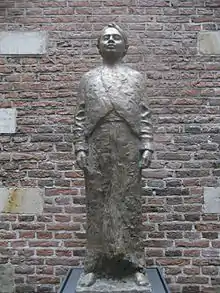Djajadiningrat family
The Djajadiningrat family was a high-ranking priyayi family in colonial Indonesia, whose members often served as Regents (district heads) of Serang in Banten, Dutch East Indies.[1][2] Noted for their western outlook and loyalty to the Dutch authorities during the colonial period, the family nonetheless fought on both sides of the Indonesian Revolution (1945–1949).[3]
History

The family is of Baduy and Bantenese extraction. According to Nina Consuelo Epton, the family's oral history recounts that in the middle of the seventeenth century, their ancestor, the renegade son of a Baduy chieftain, sought shelter at the court of the Sultan of Banten.[2] He was subsequently admitted into the inner circle of the Sultan's court and was allowed to marry one of the Sultan's daughters, thereby becoming the founder of the Djajadiningrat family.[2]

Later marriages into the Javanese reigning dynasties further cemented the Djajadiningrat family's hold on power, as was shown by the career of R. T. A. Natadiningrat and his eldest son, R. T. Sutadiningrat, who both ruled in succession as Regents of Serang.[4] The latter was succeeded by his younger brother, the progressive Raden Bagus Djajawinata.[4]
In the late nineteenth century, the family benefited from the patronage of the Dutch scholar and educator Snouck Hurgronje.[5][6][7] Hurgronje, who believed in coopting the Indonesian elite by giving their children a Dutch education, ensured the admission to the prestigious Koning Willem III School of the brothers Achmad (1877–1943) and Hossein Djajadiningrat (1886–1960), sons of Raden Bagus Djajawinata.[4][7][8] Achmad, the elder son, went on to succeed his father as Regent of Serang (1901–1924), then of Batavia (1924–1929), and served as a member of both the Volksraad (Indonesia's colonial parliament) and the Raad van Indië (Council of the Indies). Hoessein, the younger son, completed his PhD at Leiden University in 1913, and became a distinguished scholar of Sundanese, Bantense, Malay and Islamic studies.[9]
The family, like most other native Sundanese and Bantense families, originally had no surname; the Dutch-educated Achmad Djajadiningrat adopted the surname 'Djajadiningrat' in the late nineteenth century.[10] Other prominent members of the family include Achmad Djajadiningrat's son, Idrus Nasir Djajadiningrat (1920–1980), and the latter's cousin Maria Ulfah Santoso (1911–1988), both of whom were important figures in the Indonesian Revolution. The media tycoons Pia Alisjahbana and Svida Alisjahbana are the daughter and granddaughter respectively of Hisnat Djajadiningrat.
References
- Netherlands News Digest. Netherlands Information Bureau. 1944. pp. 120, 430. Retrieved 15 July 2018.
- Epton, Nina Consuelo (1974). Magic and mystics of Java. London: Octagon Press. pp. 53–55. Retrieved 8 August 2018.
- Soekarno's Mentjapai Indonesia Merdika. Southeast Asian Studies Committee, James Cook University. 1978. p. 34.
- Kartodirdjo, Sartono (2014). The Peasants' Revolt of Banten in 1888: Its Conditions, Course and Sequel: A Case Study of Social Movements in Indonesia. Springer. pp. 85–86. ISBN 9789401575430. Retrieved 8 August 2018.
- "Bijdragen tot de taal-, land- en volkenkunde van Nederlandsch-Indië". M. Nijhoff. 1989: 297–301. Retrieved 15 July 2018. Cite journal requires
|journal=(help) - "Bijdragen tot de taal-, land- en volkenkunde". M. Nijhoff. 1999: 519–541. Retrieved 15 July 2018. Cite journal requires
|journal=(help) - Laffan, Michael Francis (2003). Islamic Nationhood and Colonial Indonesia: The Umma Below the Winds. Routledge. pp. 91–94, 181–187. ISBN 9781134430819. Retrieved 15 July 2018.
- Djajadiningrat, Achmad Pangeran Aria (1936). Herinneringen van Pangeran Aria Achmad Djajadiningrat (in Dutch). G. Kolff. Retrieved 15 July 2018.
- Salam, Solichin (1990). Wajah-wajah nasional (in Indonesian). Pusat Studi Dan Penelitian Islam. pp. 430–435. Retrieved 15 July 2018.
- Heesterman, J. C. (1989). India and Indonesia: General Perspectives. BRILL. p. 77. ISBN 9004083650. Retrieved 15 July 2018.